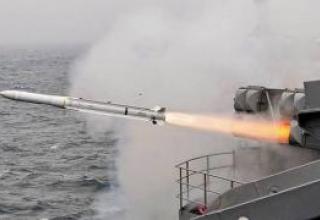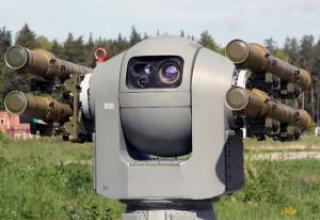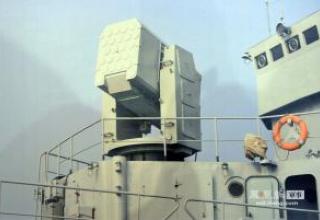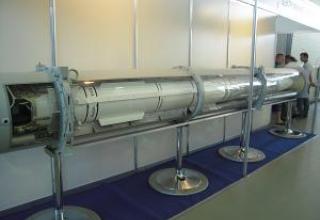On October 27, 1960, the Council of Ministers adopted Resolution No. 1157-487 on the development of the Wasp and Wasp-M anti-aircraft missile systems, respectively, for the Air Defense of the Ground Forces and Navy. The development of missiles was carried out according to common tactical and technical requirements and there were no significant differences in their design.
They were developed by the developers:
- head for the whole complex, detection stations and homing head - NII-20 GKRE (Chief Designer V.P.Efremov);
- for KB-82 missile (Chief Designer of Potapov);
- for the ship launch vehicle - CKB-34;
- propulsion plant - OKB-81 GKAT;
- combat unit - Research Institute-24;
- radio detonator - NII-571.
For complex "Osa-M" in the Central Design Bureau-34 was developed ship launch unit SM-126. But the Order of GKOT from 20.X1.1963goda work on the PU with the Central Design Bureau-34 were removed and transferred to the Central Design Bureau-7 (now PO "Arsenal"), which began to design a new starter Mill-122. In August 1964, the Design Bureau-82 was released from the rocket, and the head performer was appointed Design Bureau-2 GKAT (chief designer Grushin).
In 1967, the testing of the Osa-M complex on the pilot ship OS-24 pr.33 (former CR Voroshilov) began. In the process of testing, a number of unsuccessful design solutions were revealed, which required additional research and improvement of the equipment. After modification, the complex was tested on the ships of Pr.33. 1124 и 1134. The tests were completed in 1971. In 1973, the Osa-M SAM system was adopted for service by the Navy. The SAM system was installed on the ships of Prospect 1135. 1134B, 1135-1, 1143, 1144, 1234 and others. In the course of modernization of cruisers on the 68th Bis Avenue, the Osa-M system was installed on the Zhdanov (68-U1 Avenue) and Senyavin (68-U2 Avenue) CRs.
In 1975 modernization of the complex was started, which was named "Wasp-MA". As a result, the minimum height of the target was reduced from 60 to 25 m. Ship tests of the modernized complex were carried out on a small anti-submarine ship on the Ave. 1124 (tactical number MPK-147) on the Black Sea. In 1979, the "Osa-MA" complex was adopted for service.
In the first half of the 80-s the second modernization of the complex was carried out with the purpose of increasing the efficiency of firing at low-flying ICR. The upgraded "Wasp-MA-2" complex can hit targets flying over the crest of waves at an altitude of 5 meters.
Composition:
"The Wasp-M is fully unified with the Wasp military complex for missile 9M33 and 70% for control systems.
The control system (see photo) consists of target detection, target tracking and sighting stations for the missiles, command transmission, a console for three operators, and interface and drive control devices. Guidance of missiles at the target is provided by radio command method. Radar systems of the complex operate in a centimeter range and contain noise protection devices. In Osa-M complex it is also possible to receive target designation from the ship's detection and target designation system.
A distinctive feature of the complex "Osa-M" is that it can independently solve the problem of target detection, for which the control system includes a radar station that provides target detection, flying at an altitude of 3.5 - 4 km at a range of 25 - 30 km and at high altitudes at a range of 50 km. The coordinates of the detected and identified target are sent to the tracking station, where they are used to guide the antenna post in the bearing and search the target in the corner of the place. Due to the combination of detection and target tracking modes in one system the reaction time of the complex is reduced by 6 - 8 seconds.
The 9M33 is a single-stage rocket with a dual-mode solid propellant engine. The starting charge is telescopic and the marching charge is single-channel. The missile is configured according to the aerodynamic scheme "duck", ie has the steering wheel at the bow. The four wings are structurally combined into a wing unit, which is mounted movably relative to the hull and rotates freely in flight.
Launching unit ZIF-122 developed by the Central Design Bureau-7 under the guidance of V.A. Khromtsov. In the hiking position, the lifting unit with launching beams and rotating part is located under the deck in a special cellar, which houses the ammunition. Guide beam in the lowered state is located vertically. The missiles are placed on four drums, and five missiles can be placed on each drum. When switching to the combat position, the lifting part of the booster is lifted together with two missiles. After the first missile is launched, the drum is rotated to provide access to the line of charge for the next missile. After the second missile is launched, the launch beams automatically become vertical, turn to the nearest pair of drums, and the lifting part of the booster is lowered after the next two missiles. The PU recharging time is in the range of 16-21 seconds. Speed - 2 shots per minute on air targets and 2.8 shots per minute on surface targets, time to transfer fire to another target is 12 seconds. Weight of PU without ammunition is 6,850 kg.
After leaving the launcher and automatic (uncontrolled by radio commands) flight, the missile is "captured" by the missile sighting station and brought to the target. Guidance of the missile with the required accuracy is carried out using the command method of flight control on one of the methods implemented in the system: "three point" or "half straightening" on air targets, "three point in the NLC mode" on low-flying targets and the method of guidance on surface targets.
When the missile approaches the target, a command is given to detonate the radio fuse and remove the last stage of the fuse. On this command, the radio fuse begins to emit radiomagnetic pulses. At a certain level, the signals reflected from the target are detonated. According to the tactical and technical requirements, the maximum range of the fuse operation is 15m. In case the missile passes the target, the command to disable the radio fuse is given to the missile. The missile is brought to the water level and self-destructed by detonating the combat unit from a clockwork mechanism or destroyed by a water strike.
Characteristics:
| Mass of the rocket, kg | 128 |
| Weight of combat unit, kg | 15 |
| The length of the rocket, mm | 3158 |
| Case diameter,mm | 206 |
| Wingspan, mm. | 650 |
| ZUR flight speed, m/sec | 500 |
| Defeat zone, km | |
| - at a distance | 2..9 |
| - in height | 0,005..5 |
| - as defined in | 2-6 |
| Probability of hitting a single ZUR fighter. | 0,35..0,85 |
| Maximum speed of targets to be hit, m/s | up to 420 |
Testing:
For the first time, the compound was used in combat operations in Lebanon to repel Israeli air strikes against Syrian forces, with several planes being shot down. A wide variety of techniques have been used to reduce the fighting ability of the "Osoya". In addition to electronic suppression, unmanned aerial vehicles were launched at SAM positions, simulating the actions of combat aircraft. After the SAM stockpile was exhausted, the positions of the complexes were attacked by Israeli aircraft. Thus, in one of the battles, three Syrian Osa SAMs were destroyed as a result of that attack, but a fourth was able to destroy an Israeli RR-4E.
"The Wasp was repeatedly used in combat operations in Angola against the South African Air Force. Thus, between 1987 and 1988, two UAVs and one aircraft were shot down by an Osa SAM system unit. SAMs were used by Libya to repel air strikes by American aircraft in April 1986.
When preparing for Operation Desert Storm, U.S. military experts considered the complex as one of the most effective means of air defense in Iraq. That's why on the eve of the operation itself Multinational Task Force units captured Wasp SAM systems on the territory of Kuwait together with the calculation and technical documentation in order to study and organize effective fight against it. These SAMs became one of the priority targets for suppression by various means during the initial hostilities. However, even in such a challenging environment, the Osa SAM has proven to be one of the most effective air defence capabilities, especially against Tomahawk cruise missiles, in a massive fire and electronic countermeasure.
Sources:
- А.Широкорад "Ракеты над морем", журнал "Техника и Оружие" №5, 1996.
- Петров А. М., Асеев Д. А., Васильев Е. М. и др. "Оружие российского флота 1696-1996 гг." СПб: Судостроение
- А.В. Карпенко "Российское ракетное оружие 1943-1993". Санкт-Петербург, "ПИКА", 1993
- Зенитные ракетные комплексы ПВО СВ. Техника и вооружения №5-6.99
- Русское вооружение
- Вестник ПВО











